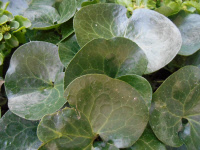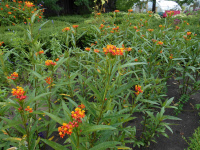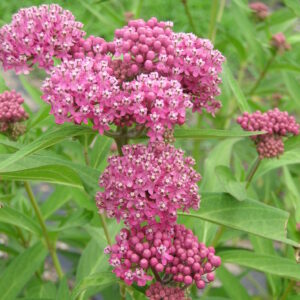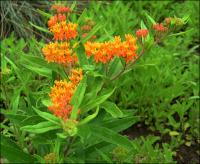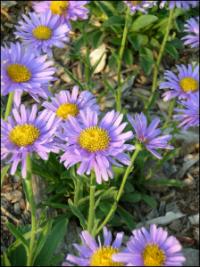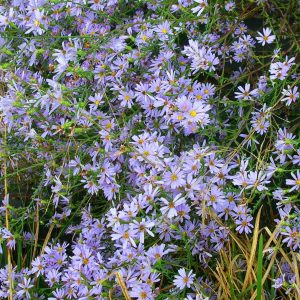Shop
Showing 89–96 of 778 results
-
Asarum canadense syn. Hexastylis canadense Wild ginger Z 3-7
Concealed brown bell-shaped flowers with flared tips hide under this groundcover's crinkled, lacquered leaves.
Concealed brown bell-shaped flowers with flared tips hide under this groundcover’s crinkled, lacquered leaves.
Size: 6" x 6" spreading
Care: part shade to shade, moist well-drained to well-drained soil
Native: Canada to So. Carolina, Wisconsin nativeNative Americans used Wild ginger for such diverse purposes as flavoring food, curing heart palpitations, induce menstrual cycles, cure “the bite of the serpent,” mend broken bones, as a general tonic, a tea and lure catfish. Winnebago tenderized raccoon meat with this. Colonists used the plant to break fever and stimulate the appetite.
-
Asarum europaeum syn. Hexastylis europaeum European snakeroot, Wild ginger Z 4-9
Glossy, kidney shaped leaves
OUT OF STOCK – EMAIL FOR AVAILABILITY
Glossy, leathery, kidney shaped leaves, dark green with lighter veins, with purplish, sepia-toned bell-like flower, hidden by the more ornamental leaves
Size: 4-6” x 12” slow spreader
Care: shade to part shade in moist to moist well-drained acidic soil
Native: Europe
Awards: Elisabeth Carey Miller Garden Great Plant Pick & England’s Royal Horticultural Society Award of Merit.According to Dioscorides in Roman times this plant cured ailments of the eyes, ears, stomach, mind and the head. Grown in the Eichstatt Garden, the garden of Johann Konrad von Gemmingen, prince bishop of Eichstatt in Bavaria, c. 1600. Gerard (1633) reported that this Wild ginger prevented increase of hard swelling cankers by topical application. Powdered root mixed with wine cured sciatica, gout, dropsie & ague. The name Asarum comes from Greek phrase “to adorn”, meaning it needs adornment.
-
Asclepias curassavica Bloodflower or scarlet milkweed Z 9-11 Annual in colder areas
Small scarlet red and orange umbels all summer and early fall
Asclepias curassavica grows upright and tall with spiraling lance-shaped leaves. Blooming all summer and early fall. Showy flowers, in small scarlet red and orange umbels.
Size: 24-30” x 12-24”
Care: sun to part shade in moist well-drained soil
Native: South America
Wildlife Value: Attracts Monarch butterfliesIn gardens since 1750’s.
-
Asclepias incarnata Swamp milkweed Z 3-9
pink umbels, like an upside down ballerina’s skirt
Fragrant medium pink umbels, like an upside down ballerina’s skirt, July – September.
Size: 3’-4’ x 2-3’
Care: Sun in moist to moist well-drained soil, deer resistant
Native: North America – all states (except along the Pacific coast) & eastern half of Canada, Wisconsin native
Wildlife Value: host for Monarch caterpillars, flowers are source of nectar for several butterfliesNamed after Asclepias, a Greek god of medicine. Native American groups used Swamp milkweed – Chippewa to increase their strength & the stems made into twine; Iroquois to heal navels in babies, to increase or decrease urine and to make a person strong enough to punish witches; Meskwaki to drive out tapeworms; and Menominee used it as an ingredient in food – added to deer soup & cornmeal mush. Listed as growing in England in Miller’s Gardeners’ Dictionary, 1768. Pressed specimen in Emily Dickinson’s herbarium.
-
Asclepias tuberosa Butterfly weed, Pleurisy-root Z 4-9
Gorgeous - July - September bright orange cymes
OUT OF STOCK
Gorgeous – July – September bright orange cymes
Size: 2-3' x 12"
Care: Sun in moist well-drained to dry soil
Native: East and south North America, Wisconsin native
Wildlife Value: Host for Monarch caterpillars and its nectar is a favorite for 13 different butterflies: 4 Swallowtails, 2 Fritillaries, Checkered white, Spring azure, Small copper, Sachem, Monarch, and Coral and Gray hairstreaks. Attracts Ladybugs that eat many insect pests.
Awards: Great Plants for Great Plains; Perennial Plant Assn. Plant of the Year 2017.Named after Asclepias, a Greek god of medicine. Omaha Indians ate the raw root to cure bronchial and pulmonary ailments, their Shell Society was the authorized guardian of the plant, taking 4 days to dig, prepare and distribute the root. Most important medicine for Menominee Indians. The Iroquois smashed roots on legs to impart strength to runners. Navajo cured coyote bites and flu with Butterfly weed. Millspaugh said used as “subtonic, diaphoretic, alternative, expectorant, diuretic, laxative, escharotic, carminative, anti-spasmodic, anti-pleuritic, stomachic, astringent, anti-rheumatic, anti-syphilitic and what not?” 1st collected by Rev. John Banister in colonial Virginia c. 1680. A gunman mistakenly shot and killed him while he collected plants. Used by natives for Bloody Flux; the Root must be powdered and given in a Spoonful of Rum, or rather as the Indians give it, bruise the Root, and boil it in Water, and drink the Decoction: Pehr Kalm saith it is excellent for the hysteric Passion.” HoChunk placed masticated root into wounds. Cultivated by Jefferson. Pressed specimen in Emily Dickinson’s herbarium.
-
Asclepias verticillata Whorled milkweed Z 4-10 POISON
Fragrant flat-topped clusters of many small white flowers atop single stem surrounded by narrow, grass-like leaves. Blooms July through October.
ARCHIVED
Note: This is a plant not currently for sale. This is an archive page preserved for informational use.
Fragrant flat-topped clusters of many small white flowers atop single stem surrounded by narrow, grass-like leaves. Blooms July through October.
Size: 12-30” x 12-24” spreading
Care: sun to part shade in moist well-drained to well-drained soil
Native: all US, Wisconsin native
Wildlife Value: deer & rabbit resistant. Bees & butterflies eat nectar. Host for Monarch caterpillars.
Size: root used to induce sweating for Choctaw, Chickasaw and Creek nativesCollected by 1753. Grown at America’s 1st botanic garden, Elgin Botanic Garden 1811.
-
Aster alpinus Alpine Aster Z 5-7
Frilly little daisies, May-June, lavender, pink or white
OUT OF STOCK – EMAIL FOR AVAILABILITY
Frilly little daisies, May-June, lavender, pink or white. Plant where they’ll be seen in the front of the garden. Also good in rock gardens
Size: 6-10" x 18"
Care: Full sun well-drained soil. Drought tolerant & tolerant of Black walnut toxins
Native: Rockies
Wildlife Value: attract butterfliesAster means star referring to the flower form. Collected by Drummond in the Rockies by 1800.
-
Aster azureus syn. Symphyotricum oolentangiense var. oolentangiense Sky blue aster Z 3-9
Showy true cornflower-blue daisies in August-October
ARCHIVED
Note: This is a plant not currently for sale. This is an archive page preserved for informational use.
Showy true cornflower-blue daisies in August-October
Size: 2-3’ x 2’
Care: full sun to part shade in any soil
Native: NY to SD, FL to TX incl. WI
Wildlife Value: Aster species are nectar sources for many butterflies – Checkered white and Checkered skippers, Spring azure, Pearl crescent, Buckeye, Painted lady, Fiery skipper, Sachem, Sleepy orange, Silver-spotted skipper and Monarch.Collected before 1889.


